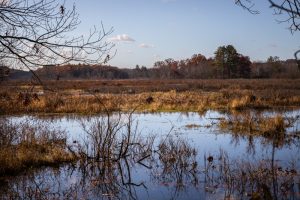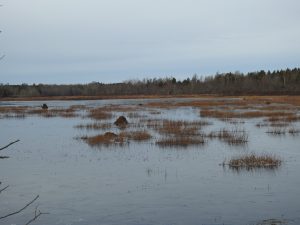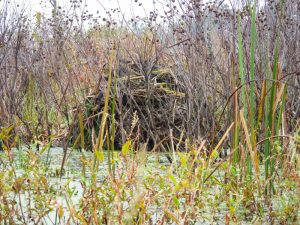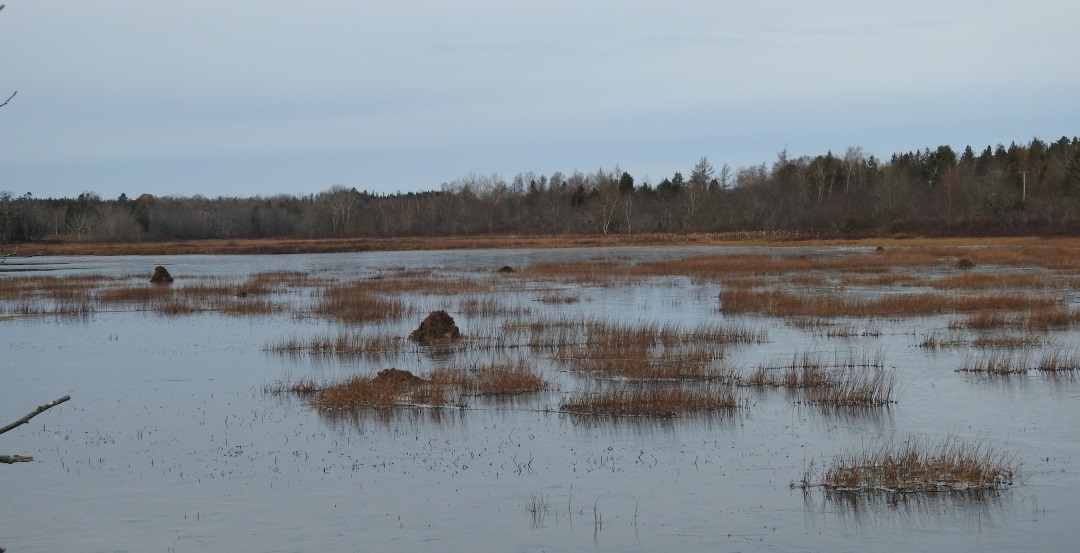Water Closet for December 1, 2017
[pullquote]”Muskrats, like most rodents, have a high reproductive rate. This far north a healthy female in a good environment may have upwards of 3 litters of 6 annually, but here these youngsters don’t mature until they are about a year old”[/pullquote]2017 may be good year for muskrats along our Ipswich River, its wetlands and elsewhere. In early November Middleton Stream Teamers (MST) and friends paddled upriver from Farnsworth Landing off Route 114. Near the channel for a mile, twenty striking new structures of mud and soft vegetation that hadn’t been there a few weeks earlier stood three feet above the beaver impounded water. The paddlers in previous years had never seen so many muskrat lodges. They are under a tenth the size of beaver lodges and not made of sticks. The paddlers immediately recognized them as muskrat lodges quite different than the muskrat tunnel homes unseen along the river’s banks. Has the muskrat population increased here to where the labyrinthine bank tunnels will no longer hold them all? The paddlers, never trappers, plan to ask trappers who long ago as lads trapped muskrats and other aquatic mammals for pelt money. A few days ago MST received the following essay about muskrats from naturalist Fred Gralenski 200 miles Downeast in Pembroke, ME. Included with his piece, which he has kindly allowed us to publish, is a photo of a Downeast marsh with lodges like those the Stream Teamers and friends saw here.
QUODDY NATURE NOTES by Fred Gralenski
Muskrats
Muskrats are critters that are pretty common here in the Quoddy region, as we have a lot of swamps with reeds, cattails, sedges, water lilies and other aquatic vegetation to their culinary liking. It is a little confusing as to how they got their name. My Passamaquoddy reference book lists muskrat as ‘Kiwhos’, but another reference states the Wabanaki native word as ‘Moskwas,’ Supposedly the early English colonists spoke this as ‘Musquash’, and we know that there are dozens of lakes, swamps and streams in New England now named ‘Musquash.’

Ipswich River flooded by beaver dams makes ideal muskrat habitat. How many lodges can you see in this photo of the floodplain in Danvers and Middleton above Route 114? –
Judy Schneider photo
Whatever we call them, muskrats are interesting members of our wildlife. They can live anywhere there is at least a quarter acre of fresh water, and that water doesn’t have to be very clean by anything else’s standards. They have been known in sewage lagoons and streams polluted by mine tailings. Muskrats can live in salt water but they need a source of fresh water to hydrate. Apparently some of the outer islands around here and in the Canadian Maritimes had been stocked with muskrats in an effort to enhance the trapping industry. I remember meeting a fellow that had participated in this effort, and he claimed that the offshore pelts were prized and a premium was paid for them. This enterprise was not appreciated by bird lovers, as although muskrats are primarily herbivores, they were not averse to adding a few eggs and even some baby birds to their diet. The trapping industry used to be quite lucrative and in the early 1900’s some farms were even started to raise muskrats. It was for this reason that muskrats were introduced to northern Europe, South America and Asia, but worldwide and especially in the Western hemisphere the demand for animal fur has greatly decreased. Maine does have a trapping season, and in the Quoddy region muskrat trapping season for licensed trappers is from October 29th and, with additional restrictions, through March 31st. The price per pelt is anticipated to be in the $4.00 range.

Muskrat lodges and pushups on the Pennamaquam River in way Downeast, Maine. Fred Gralenski photo
Muskrats, like most rodents, have a high reproductive rate. This far north a healthy female in a good environment may have upwards of 3 litters of 6 annually, but here these youngsters don’t mature until they are about a year old. As the population expands a noticeable change may occur in the area, as favorite foods like cattails may disappear. If a farm is nearby, the corn crop and many types of vegetables are at risk. Farm ponds with an earthen dam are often damaged from the burrowing rodents. In many European countries like the Netherlands and Belgium, muskrats are considered an invasive pest, and in New Zealand the muskrat is classed as a “prohibited new organism”, however in sparsely populated Canada, muskrat fur is valued and used to make the winter hats for the Royal Canadian Mounted Police.

Middleton muskrat lodge among button bushes in floodplain near Ipswich River channel.
This lodge is one of twenty counted in November within a mile upriver from Route 114. – Judy Schneider photo
By this time of year the muskrats are ready for winter. Some muskrats live in the banks of the water body and their home sites are not readily visible, but if you look out on the shallow marsh that is their neighborhood, you will see two sizes of piles of aquatic weeds. The biggest pile is the lodge. This is like a small beaver lodge, but with few if any wooden pieces and only a little mud. Inside is the living chamber, which is above the water level and dry, there is room for 2-4 animals and with up to two plunge holes to the water. The smaller pile of weeds is the feeding shelter (pushup), and this is large enough for one adult muskrat. There may be more than one pushup per lodge, but that’s the typical setup. Bring on the Montreal express! Our muskrats are ready!
_________________________________________________________
WATER RESOURCE AND CONSERVATION INFORMATION
FOR MIDDLETON, BOXFORD AND TOPSFIELD
| Precipitation Data* for Month of: | Aug | Sept | Oct | Nov | |
| 30 Year Normal (1981 – 2010) Inches | 3.37 | 3.37 | 4.44 | 4.55 | |
| 2017 Central Watershed Actual | 1.22 | 2.44 | 4.03 | 2.6 | |
Ipswich R. Flow Rate (S. Middleton USGS Gage) in Cubic Feet/ Second (CFS):
For Nov 24, 2017 Normal . . . 55 CFS Current Rate . . .34.8 CFS
*Danvers Water Filtration Plant, Lake Street, Middleton is the source for actual precipitation data thru Oct..—————————————————————–
** Middleton Stream Team is the source of actual precipitation data for Nov.
Normals data is from the National Climatic Data Center.
THE WATER CLOSET is provided by the Middleton Stream Team: www.middletonstreamteam.org or <MSTMiddletonMA@gmail.com>


inciter hello my website is inciter
honista hello my website is honista
citrine hello my website is citrine
joki ml hello my website is joki ml
Gorgeous hello my website is Gorgeous
gede 4d hello my website is gede 4d
nagabet hello my website is nagabet
GX6632 hello my website is GX6632
js加密 hello my website is js加密